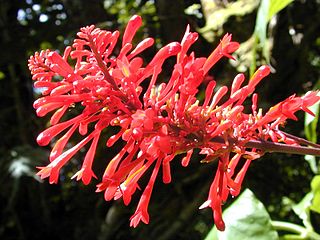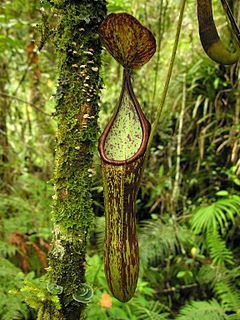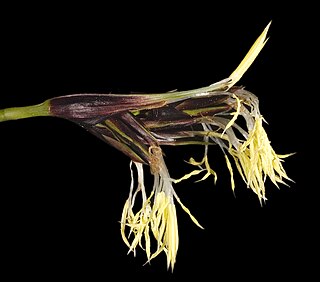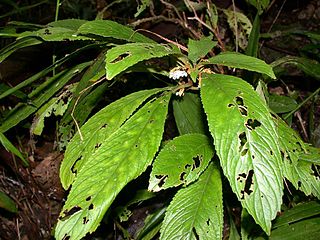
Acanthaceae is a family of dicotyledonous flowering plants containing almost 250 genera and about 2500 species. Most are tropical herbs, shrubs, or twining vines; some are epiphytes. Only a few species are distributed in temperate regions. The four main centres of distribution are Indonesia and Malaysia, Africa, Brazil, and Central America. Representatives of the family can be found in nearly every habitat, including dense or open forests, scrublands, wet fields and valleys, sea coast and marine areas, swamps, and mangrove forests.

The Cyperaceae are a family of graminoid (grass-like), monocotyledonous flowering plants known as sedges. The family is large, with some 5,500 known species described in about 90 genera, the largest being the "true sedges" genus Carex with over 2,000 species.

Aralia, or spikenard, is a genus of the family Araliaceae, consisting of 68 accepted species of deciduous or evergreen trees, shrubs, and rhizomatous herbaceous perennials. The genus is native to Asia and the Americas, with most species occurring in mountain woodlands. Aralia plants vary in size, with some herbaceous species only reaching 50 centimetres (20 in) tall, while some are trees growing to 20 metres (66 ft) tall.

Strobilanthes is a genus of about 350 species of flowering plants in the family Acanthaceae, mostly native to tropical Asia and Madagascar, but with a few species extending north into temperate regions of Asia. Many species are cultivated for their two-lipped, hooded flowers in shades of blue, pink, white and purple. Most are frost-tender and require protection in frost-prone areas.
Dr. Charles M. Clarke is an ecologist and botanist specialising in the carnivorous plant genus Nepenthes, for which he is regarded as a World Authority. Clarke has an honours degree in Botany from Monash University in Melbourne, and a Ph.D. in Ecosystem management at the University of New England, in Armidale, New South Wales.

Nepenthes ephippiata, or the saddle-leaved pitcher-plant, is a tropical pitcher plant endemic to Borneo. It occurs in the Hose Mountains of central Sarawak, as well as Mount Raya and Bukit Lesung in Kalimantan. Non-climbing plants from the Hose Mountains appear to have less decurrent leaf attachment than specimens from Central Kalimantan, however the characteristic saddle after which the species is named is fully developed in climbing plants. Nepenthes ephippiata is closely related to N. lowii.

Nepenthes copelandii is a species of pitcher plant native to the island of Mindanao in the Philippines. Originally known from Mount Apo near Davao City and Mount Pasian near Bislig, it has since been discovered on a number of peaks throughout Mindanao. It may also be present on the nearby island of Camiguin. The species has a wide altitudinal distribution of 1100–2400 m above sea level. Nepenthes copelandii has no known natural hybrids. No forms or varieties have been described.

Dicliptera is a genus of flowering plants in the bear's breeches family, Acanthaceae. Well-known synonyms include Peristrophe and Dactylostegium.

Madhuca is a genus of plants in the family Sapotaceae first described as a genus in 1791.

Machaerina (twigrush) is a genus of flowering plants in the sedge family. Its species occur in tropical America, the West Indies, Malesia, Australia and the Pacific region. The name comes from the Greek machaira, alluding to the shape of the leaves in the type species – Machaerina restioides.

Phlogacanthus is a genus of flowering plants in the family Acanthaceae and tribe Andrographideae. Its distribution includes India through to Indo-China, southern China and Sulawesi.

Tetraria is a genus of flowering plants in the sedge family, Cyperaceae, native to Tanzania, South Africa, Borneo, Australia and New Zealand.

Rhynchotechum is a genus of plants in the family Gesneriaceae, subfamily Didymocarpoideae. Species distribution records are mostly from India, Sri Lanka, China through to southern Japan, Indo-China and Malesia through to New Guinea.

Lysionotus is a genus of flowering plants in the family Gesneriaceae. It occurs in the Himalayas, China, Japan, and Southeast Asia. The genus was described by David Don in 1822.
Beccarinda is a genus of flowering plants belonging to the family Gesneriaceae.
Hermbstaedtia is a genus of flowering plants belonging to the family Amaranthaceae.
Rungia is a genus of flowering plants belonging to the family Acanthaceae.
Rostellularia is a genus of flowering plants belonging to the family Acanthaceae.












